
Nepenthes tentaculata, or the fringed pitcher-plant, is a tropical pitcher plant with a wide distribution across Borneo and Sulawesi. It grows at altitudes of 400–2550 m.

Nepenthes reinwardtiana is a tropical pitcher plant native to Borneo and Sumatra and to a number of smaller surrounding islands including Bangka, Natuna, Nias, and Siberut. Although some sources have included Peninsular Malaysia and Singapore within the range of this species, these records appear to be erroneous.

Nepenthes veitchii, or Veitch's pitcher-plant, is a Nepenthes species from the island of Borneo. The plant is widespread in north-western Borneo and can also be found in parts of Kalimantan. It grows in lowland Dipterocarp forest, typically near rivers, and on ridgetops in mossy forests, from 0 to 1,600 meters elevation. Nepenthes veitchii usually grows as an epiphyte, though the form from Bario seems to be strictly terrestrial and has not been observed to climb trees.
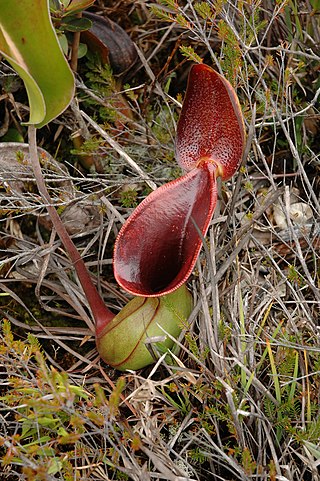
Nepenthes lowii, or Low's pitcher-plant, is a tropical pitcher plant endemic to Borneo. It is named after Hugh Low, who discovered it on Mount Kinabalu. This species is perhaps the most unusual in the genus, being characterised by its strongly constricted upper pitchers, which bear a greatly reduced peristome and a reflexed lid with numerous bristles on its lower surface.

Nepenthes fusca, or the dusky pitcher-plant, is a tropical pitcher plant endemic to Borneo. It is found throughout a wide altitudinal range and is almost always epiphytic in nature, primarily growing in mossy forest.
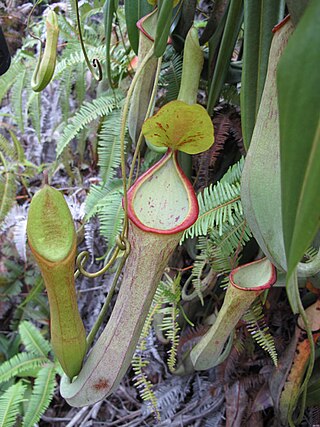
Nepenthes macrovulgaris, or the serpentine pitcher-plant, is a tropical pitcher plant endemic to Borneo. It is a lowland plant that typically grows at altitudes ranging from 300 to 1200 m in sub-montane forest clearings and mossy forest. Its range is restricted to ultramafic habitats, including Mount Kinabalu, Mount Tambuyukon, the Danum Valley, the Tawai Range, the Meliau Range and Mount Silam, all in Sabah, Malaysian Borneo. Pitchers grow to around 25 cm high and range in colour from green to brown, with the speckled form being the most common.

Nepenthes stenophylla, or the narrow-leaved pitcher-plant, is a tropical pitcher plant endemic to Borneo. The species produces attractive funnel-shaped pitchers up to 25 cm high. It is listed as Least Concern on the IUCN Red List. Nepenthes stenophylla belongs to the loosely defined "N. maxima complex", which also includes, among other species, N. boschiana, N. chaniana, N. epiphytica, N. eymae, N. faizaliana, N. fusca, N. klossii, N. maxima, N. platychila, and N. vogelii.
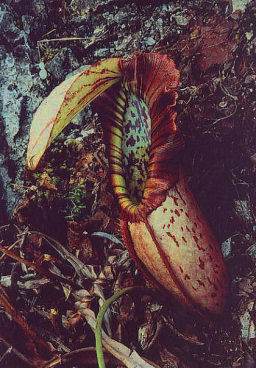
Nepenthes northiana, or Miss North's pitcher-plant, is a tropical pitcher plant endemic to Borneo, where it grows at elevations ranging from 0 to 500 m above sea level. The specific epithet northiana honours the English botanic illustrator Marianne North, who first depicted the species. Nepenthes northiana is one of the most famous Nepenthes, and its discovery in the latter half of the 19th century contributed to Sarawak's reputation as a land of spectacular exotic plants.

Nepenthes clipeata, or the shield-leaved pitcher-plant, is a tropical pitcher plant known only from the near-vertical granite cliff faces of Mount Kelam in West Kalimantan, Indonesia. It has an elevational distribution between approximately 600 and 800 m.

Nepenthes pilosa is a tropical pitcher plant endemic to Borneo. It is characterised by a dense indumentum of long yellow-brown hairs. Pitchers have a distinctive hook-shaped appendage on the underside of the lid. The specific epithet derives from the Latin word pilosus, meaning "hairy".

Nepenthes hurrelliana is a tropical pitcher plant endemic to Borneo, where it has been recorded from northern Sarawak, southwestern Sabah, and Brunei. It is of putative hybrid origin; its two original parent species are thought to be N. fusca and N. veitchii. A thick indumentum of rusty-brown hairs covers the entire plant, a characteristic presumably inherited from the latter.

Nepenthes hispida is a tropical pitcher plant species native to Borneo. It grows at elevations of 100 to 800 m in kerangas forest. It is known with certainty only from Lambir Hills National Park and surrounding areas.
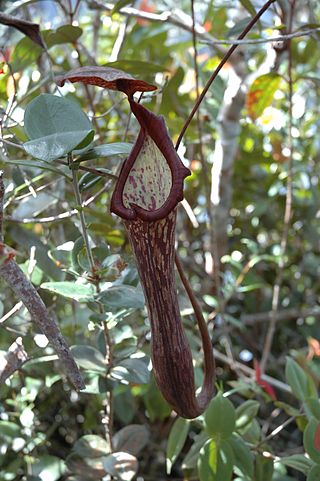
Nepenthes faizaliana is a tropical pitcher plant endemic to the limestone cliffs of Gunung Mulu National Park in Sarawak, Borneo. It is thought to be most closely related to N. boschiana.

Nepenthes mapuluensis, the Mapulu pitcher-plant, is a species of tropical pitcher plant native to East Kalimantan, Borneo. It is known only from a restricted geographical range and is listed as Endangered on the IUCN Red List.
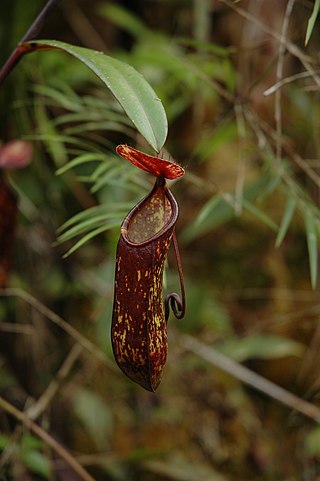
Nepenthes muluensis, or the Mulu pitcher-plant, is a tropical pitcher plant endemic to Borneo. It grows in highland habitats at elevations of 1700 to 2400 m above sea level.

Nepenthes vogelii is a tropical pitcher plant endemic to Borneo. It is thought to be most closely related to N. fusca.

Nepenthes of Borneo is a monograph by Charles Clarke on the tropical pitcher plants of Borneo. It was first published in 1997 by Natural History Publications (Borneo), and reprinted in 2006. Clarke describes it as "primarily an ecological monograph".

Pitcher-Plants of Borneo is a monograph by Anthea Phillipps and Anthony Lamb on the tropical pitcher plants of Borneo. It was first published in 1996 by Natural History Publications (Borneo), in association with the Royal Botanic Gardens, Kew and the Malaysian Nature Society. An updated and much expanded second edition was published in 2008 as Pitcher Plants of Borneo, with Ch'ien Lee as co-author.

Nepenthes of Mount Kinabalu is a monograph by Shigeo Kurata on the tropical pitcher plants of Mount Kinabalu and the surrounding area of Kinabalu National Park in Sabah, Borneo. It was published in 1976 by Sabah National Parks Trustees as the second booklet of the Sabah National Parks series. The monograph is Kurata's most important work on Nepenthes and significantly contributed to popular interest in these plants. It is noted for its high quality colour photographs of plants in habitat. In the book's preface, Kurata writes:
While Nepenthes were often enumerated as an important component of the flora of this mountain, a book on this genus—relating exclusively to Kinabalu had never been published to this date. With such a situation and the interest shown by visitors to the Kinabalu National Park in the genus, Mr. D.V. Jenkins, Assistant Director, Sabah National Parks was prompted to publish a guide book on the species found within the park and I was delighted to be asked to write the text.


























